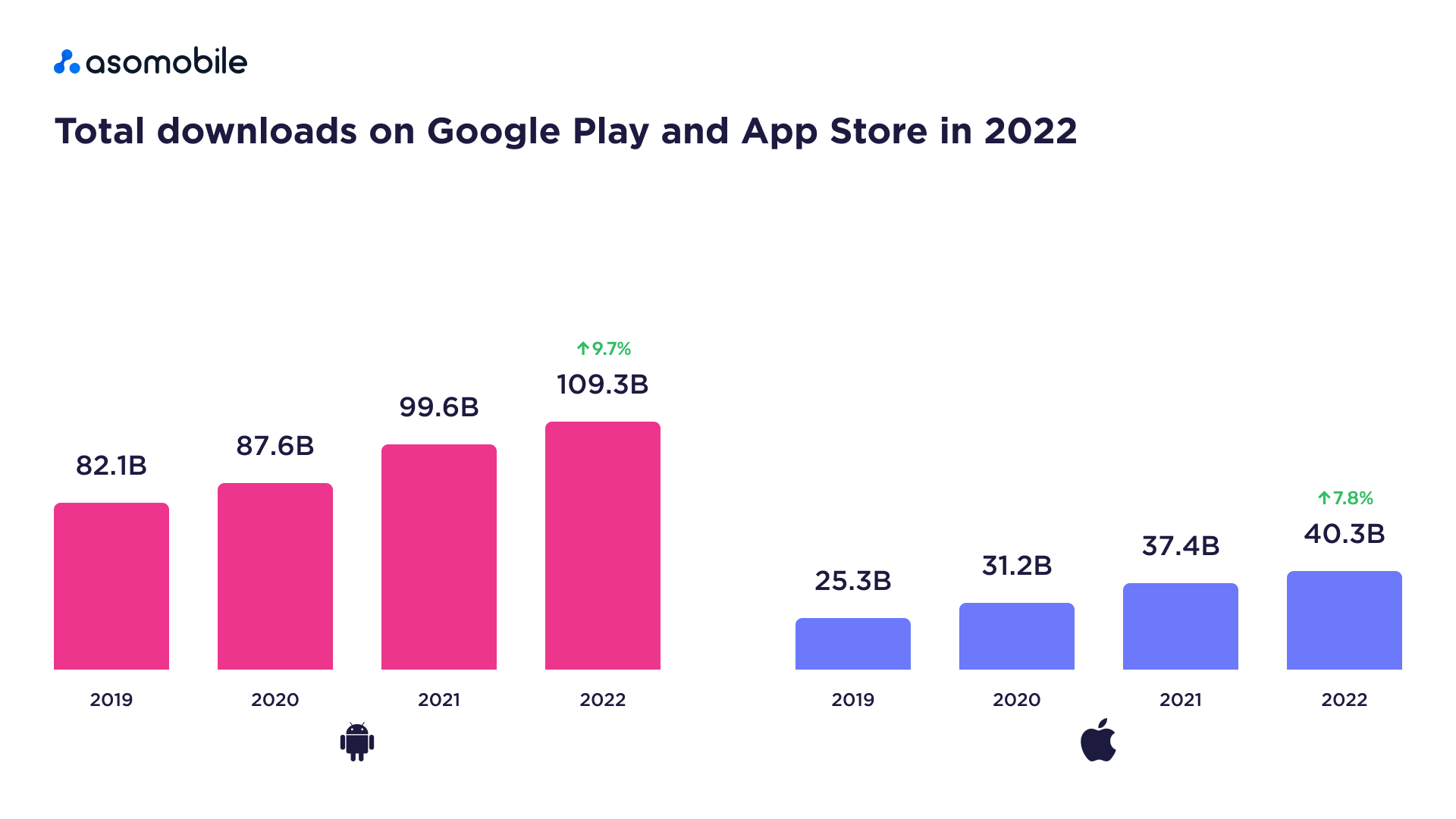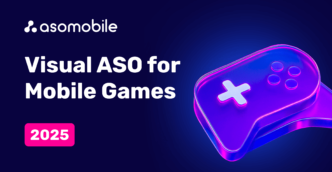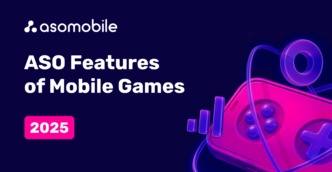Localization of your app on Google Play
One of the very first steps you will take to expand your user base is a localization of your app, and here we will see how to do it on Google Play.
Google Play was released in 2008 and was then called the Android Market. At that time, Google did not consider the app store to be its main source of income. And how things have changed a few years later. In 2012 Android Market became Google Play and combined Google Music, Google Movies, and Google eBookstore into one brand. In the following years, Google actively used the Play brand until 2018, when its decline began.

Let's take a look at how Google Play is doing today. It would be most logical to do this with an eye to 2022 since complete data for the past year is already available. The pandemic and the transition to the digital world, which has become even more active at the expense of the first, contributed to the growth, or more precisely, to the jump in the number of downloads and the growth of downloads. While the number of downloads increased, their growth rate began to decline. The results of 2022 clearly reflected this by the absence of an increase in the growth rate. The increase in downloads on the Google Play store was +9.7%.
What's with the revenue? If for 2020 with its + 12.9% and 2021 with a serious jump to + 17%, we can speak excitedly, then unfortunately, 2022 turned out to be not at all what we would like. 0.8%, and unfortunately, this is directly related to the slowdown in the growth of installs. And this is inevitable due to the fact that the market is saturated and saturated with new applications; the growth of competition follows the previous factor in step, and immediately after them, the improvement in the quality of applications, which includes the optimization of existing ones.
And how can you break into this stream of new apps so that everyone notices and everyone likes it?
In this case, we have a good article. Today we will consider such a helpful thing as localization, and to be a little more precise, localization on Google Play.
We chose Google Play due to the fact that Android is currently the leader of the operating systems in the world in terms of numbers, then it will be an impressive 71.1% of the global market as of March 2022. Google Play supports more than 77 languages and their varieties.
Why do we need localization, and what is it, anyway?
Let's get it clear! First and foremost, localization in mobile applications is the adaptation of your app to a specific geographic location. And no, it's not just the language! You need to remember the context in which people live. Let's look at an example. You have an app with recipes and how to cook. And you are in a country with developed fisheries. It will be logical for your region to include in the screenshots a couple of recipes or pictures indicating the presence of fish-related recipes. And without localization, you will see a recipe for cooking octopus, for example, in Portugal and Poland. If for Portugal, this context is appropriate; then for a user in Poland, it is simply not relevant.
Small conclusion. Localization should keep the user in focus to improve the experience of interacting with the application. Yes, it's obvious enough, but sometimes it's better to repeat the obvious. Interacting with your application, the user must feel that it is relevant for him and coincides with what he wants.
The goal of localization is the same as the goal of ASO optimization, which is to increase the number of conversions for your app. Actually, localization is part of ASO, so it is not surprising that the goal is the same. This is achieved by translating the application into the user's native language and adapting the app to the realities in which the user lives. It is worth noting that the localization of the entire game or application is not the cheapest pleasure, although it is the most effective. When it comes to localizing a page on Google Play, then ASO optimization comes into play. It will give the game more visibility and help increase conversions. And if you localized only the page on the store, then the main thing is that the language of the app itself is English, otherwise there is a high probability of getting1 star
App UI localization
In this section, we will focus on language translation. But what about the relevance, cultural and life context? They are important, but at the moment the best tools in terms of accessibility and optimality to help you adapt your application will be search engines and analysis of the information received. We have to point out that the best “tool” for localization in general will be a native speaker of the language you are translating into and who lives in the locality for which you will localize. That is, there is a “tool”, but it is very difficult to find it. Therefore, we noted such an important detail as “optimality”. If native speakers who live in your area and who are competent for your task were easily available, then we would all be happy.
Well, let's start! Remember that before you start localizing your application must have a basis for localization. And most likely you have already guessed that English will be a good foundation because of its versatility and its prevalence. You don't have to be trendy, though, if you know your app will excel in the region you're targeting. We still advise sticking to English as the basis. But remember that it is better to start doing localization after the base is completely ready, otherwise it will lead to various difficulties.
With the foundation in place, you can start choosing a second language for your app. The metric of where your app is most popular will help you choose. And we are forced to make an amendment that it will not always be only one language. If your application is popular in Cyprus, then you need to know that Greek and Turkish are used there. Therefore, it makes sense to localize two languages simultaneously.
Now you can definitely start. Once there is a basis, you can start translating into other languages. Who and what can help you with this:
- A lucky match. When one of your employees speaks at a serious level the language that you need. A person who is familiar with the application as closely as possible. Just remember that when giving one job to an employee, you need to relieve them of the duties of the one that they had.
- There are many services that will gladly help you with this, ranging from translation agencies to specialized localization agencies. The quality of the translation will be more than satisfactory.
- The easiest and fastest way is provided by Google Play itself. This is a machine translation produced by Google Translate. Although Google Translator has improved a lot in recent years. Still, we do not recommend using it as the tool that will do the main translation for you. However, that is a feature that you might find useful
Important! To start localization properly, you need to start a process called internalization. Don't be alarmed, it just shows the store that your app won't be or is no longer limited to just one language. This is a sign that you will move towards expanding the languages that are available in your app.
Metadata localization
Localization of metadata is a very important process, which is directly related to the visibility of the app on Google Play. This is necessary in order to increase the visibility and conversion of the app in a certain region. Without localization in all regions, you will have the same thing, and we have suspicions that different things are relevant in different parts of the world.
Why ASO and not translation?
After all, it will be the same. No! While translation, sorry for the tautology, just translates without regard to relevance, the goal of ASO is to increase the level of visibility and downloads of your application. There is no easy translation here. Texts will most often be rewritten with a new semantic core. The visual will be adapted to the region, etc. As you can see, there is a difference and it is important.
What kind of metadata is localized?
- Text: short and long description, title. In order to localize the description and title, we will need to re-create the semantic core and write the text with an eye to it. This is not just a translation, you know
- Name. This aspect is not so simple. This is where the plasticity of language and the need for translation come into play. Let's start with the last one, the need for translation is more of a question for you than a statement. For example, if your name is your brand, then it is better to leave it in English. Or you have a non-standard name with imitation of sounds and it reflects some aspect of the game, here you will have to think about how much translation is needed and something will not be lost along the way. Although, on the other hand, translation can help to find your application easily. As you can imagine, this is another useful tool in your arsenal.
- Screenshots. Screenshots are the main element that conveys information about your application to the user. Therefore, their localization is extremely important.
- Your app icon can also be localized if the context of the geographic location requires it. We need it to resonate with users in some way, and localization can help with this.
- Video. Video localization is an optional thing due to the fact that a very small percentage of users watch the video for a long time and the number of those who watch it to the end is also low. Therefore, the videos will most often be in English. In most cases, video will be subject to localization if you made it not “universal”.
How to recognize high-quality localization?
Let's get a look! Everything follows very logically from the rules of ASO optimization, so here you will find the answers as logical as possible.
- The text is written with the optimal number of characters, there is no keyword stuffing and the semantic core is composed of words that will best increase the conversion and visibility of the application
- visual elements. Labels, icons, screenshots, etc. the potential of all this must be used to the maximum. Something calls for action, something attracts attention and makes you go to the application page. You can read more about visualization and its trends in our article.
- The video should be interesting from the first frames and in the first few seconds. Because as mentioned above, only a small percentage of users will pay their attention to the video. But remember that the video cover can be used as it will be displayed as a screenshot
- Naturally, the last instance of good localization is the user. If you have bad reviews on one of the localizations, then you need to think about it.
What to avoid when localizing
Machine translation. It has already been mentioned in this article, but we think that a separate emphasis should be made. You do not need to use this type of translation as a basis for the next one or as what you will have on the app page. For example, a trivial selection of words, the machine chooses not the word that is most suitable, but the one that is most often used as a translation of the translated word.
Since we are talking about the choice of words, it would be logical to discuss the semantic core, which naturally disappears during machine translation. Although Google Play has an option to select keywords for another language. We still recommend that you use the services of companies that focus on ASO optimization or their products. The semantic core is what directly affects the visibility of your application in the search and its position. Do I need to say now how important it is and whether it is worth trusting its equipment to the machine?
After the core is ready, another problem appears on our way, namely text oversaturation. If you constantly use the most popular keywords, then Google Play will label your text as spam and that's it. You will achieve the exact opposite result, the visibility of the application will simply decrease.
Change visual elements if required by localization. No need to leave the same visual for a different localization when they don't match. Words change form, phrases become shorter or longer. Adapt, draw a smaller window or expand the button. Otherwise, you are threatened to be accused of doing that in a slipshod manner.
Mobile analytics tools for successful localization
Let's take a look at the tools we have available to help make the process of localizing your metadata easier and more efficient.
Worldwide Check
Detailed instructions on how to use this tool can be found in our article. But in terms of app localization, you can safely use Worldwide Check to research keywords in 60+ countries around the world. If you decide to win over a Spanish-speaking audience with a football statistics app that has already made a splash among English-speaking users, then the first step is to understand which keywords are relevant in each country. And if soccer was good in the US, would it be as good in Spain?
To do this, you use Worldwide Check, in two clicks, you get a keyword analysis in the selected countries:

Top Keywords
This tool will allow you to see the top keywords in each country, something to consider when localizing your app store page

Trending Searches
Another tool with which you can get an up-to-date summary of the most popular keywords every hour, day, and month. In Trending Search, you can also conduct keyword research in the context of the selected store and country. We need to mention - this tool shows you only App Store trending, but you can use this information for Google Play after checking.

App text optimization tools:
Localization of your metadata is practically no different from any other ASO optimization. Therefore, we boldly apply all the steps and sequences for text optimization:
- We collect the semantic core using App Keywords, Keyword Finder, Keyword Select, Keyword Suggest.
- We analyze the semantic core using Keyword Monitor, Suggest Checker.
- We compile app metadata in ASO Creator and Text Analyzer. The last tool is especially relevant for metadata (descriptions) on Google Play.
Visual App Optimization
As already mentioned, localization is not just text and its translation, it is the maximum adaptation of your app to the local user. Considering visual optimization trends in each country can sometimes be even more important than all your other efforts. After all, it is the visual elements that are responsible for the final result - the installation.
Visual Comparison will allow you to catch trends quickly, look at competitors and at yourself against their background.

Let's draw conclusions
Localizing apps on Google Play has a number of advantages. First, localized apps can attract new users who are looking for apps in their own language. Second, app localization can improve user retention and increase downloads because users will more easily understand and use the app in their native language. Thirdly, localized apps can increase the app ranking in the Google Play Store because Google takes regional factors into account when rating apps.
Localization of the app page on Google Play is also essential to increase app downloads. The key elements of a localized app page are the app name, description, screenshots, and video. Developers should pay particular attention to choosing keywords and describing the app in each language, and using the correct characters and formatting for each localization. It is also recommended to use mobile analytics tools for easier and more efficient localization.
 Українська
Українська  Русский
Русский  Español
Español 






